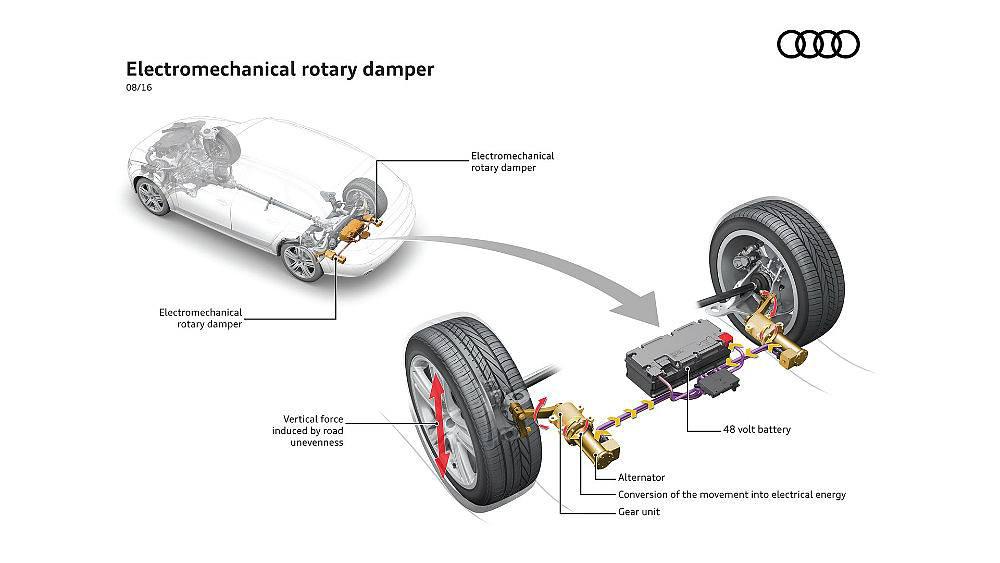Audi eROT suspension prototype converts wasted energy into electricity
I cringe when I hit potholes or lumps-it’s worse when I don’t see them until the last minute. This frustration is an opportunity for Audi to launch a new suspension prototype called eROT. This technology replaces traditional hydraulic shock absorbers with electromechanical shock absorbers, but the risk it faces is not only the ride quality.
According to the automaker, energy recuperation plays an important role in the vehicles of the future.
Suspension Strategy
Energy Strategy
Suspension Strategy
There are two essential parts to eROT, the first of which seems straight forward. eROT is an active suspension, adjusting to road imperfections and irregularities accordingly for a more refined feel. eROT eliminates the rebound and compression strokes of traditional hydraulic dampers; Audi can now configure a better, more stable compression stroke without interrupting the damping of the rebound stroke.
“It presents us and our customers with entirely new possibilities for adjusting the suspension,” said Dr.-Ing. Stefan Knirsch, Board Member for Technical Development at Audi AG.
Energy Strategy

Beyond a smooth ride, eROT converts kinetic energy during compression and rebound into electricity with a lever arm. The lever arm transmits this force through a series of gears to an electric motor, which then converts it into electricity. The average recuperation output was anywhere from 100 to 150 watts during testing on German roads. On a smooth freeway, the numbers were in the single digits, but on rougher terrain, it was over 600 watts.
Audi concludes the typical customer can record a CO2 savings of 4.8 grams per mile. According to Dr. Knirsch, there are plenty of opportunities for eROT to shine.
“Every pothole, every bump, every curve induces kinetic energy in the car,” he explained. “
Today’s dampers absorb this energy, which is lost in the form of heat. With the new electromechanical damper system in the 48-volt electrical system, we put this energy to use.”
The 48-volt electrical system Dr. Knirsch is referring to is what Audi’s eROT prototype is based on. Currently, its lithium-ion battery has an energy capacity of 0.5 kilowatt hours, with a peak output of 13 kilowatts. A DC converter connects the 48-volt electrical subsystem to the 12-volt primary electrical system, which includes a high-efficiency, enhanced output generator.
The initial tests are positive and eROT might be included on Audi’s production vehicles one day. The electric motors are even placed in the rear axle area in such a way as to not effect cargo space.
*Carl Anthony is Managing Editor of Automoblog and resides in Detroit, Michigan.
Photo & Source: Audi AG
-
Latest
 Automoblog In-Depth: The terrible reality of Halloween
Automoblog In-Depth: The terrible reality of HalloweenThe scariest thing about this Halloween season has nothing in common with the latest biometrics on Netflix. Although trick-or-treating without sugar is a treat for children and families, once the porc...
-
Next
 5 low-cost fuel economy solutions
5 low-cost fuel economy solutionsAt the time of writing, the national price of a gallon of regular grade fuel is about $2.00 per gallon, which is about 40 cents lower than a year ago. Americans are frantically snapping up trucks and...
Popular Articles
- Ivy Charging Network cooperates with the Ontario municipal government to build a level 2 charger
- The Canadian government invests in a clean car and aerospace center in Hamilton
- Mitsubishi Motors Canada Appoints Kenji Harada as New President and Chief Executive Officer
- Nissan announces Canadian pricing for the new 2021 Rogue
- FedDev Ontario invests in Canada's first car accelerator in Windsor-Essex
- 2019 Volvo V60 unveiled, emphasizing versatility and safety
